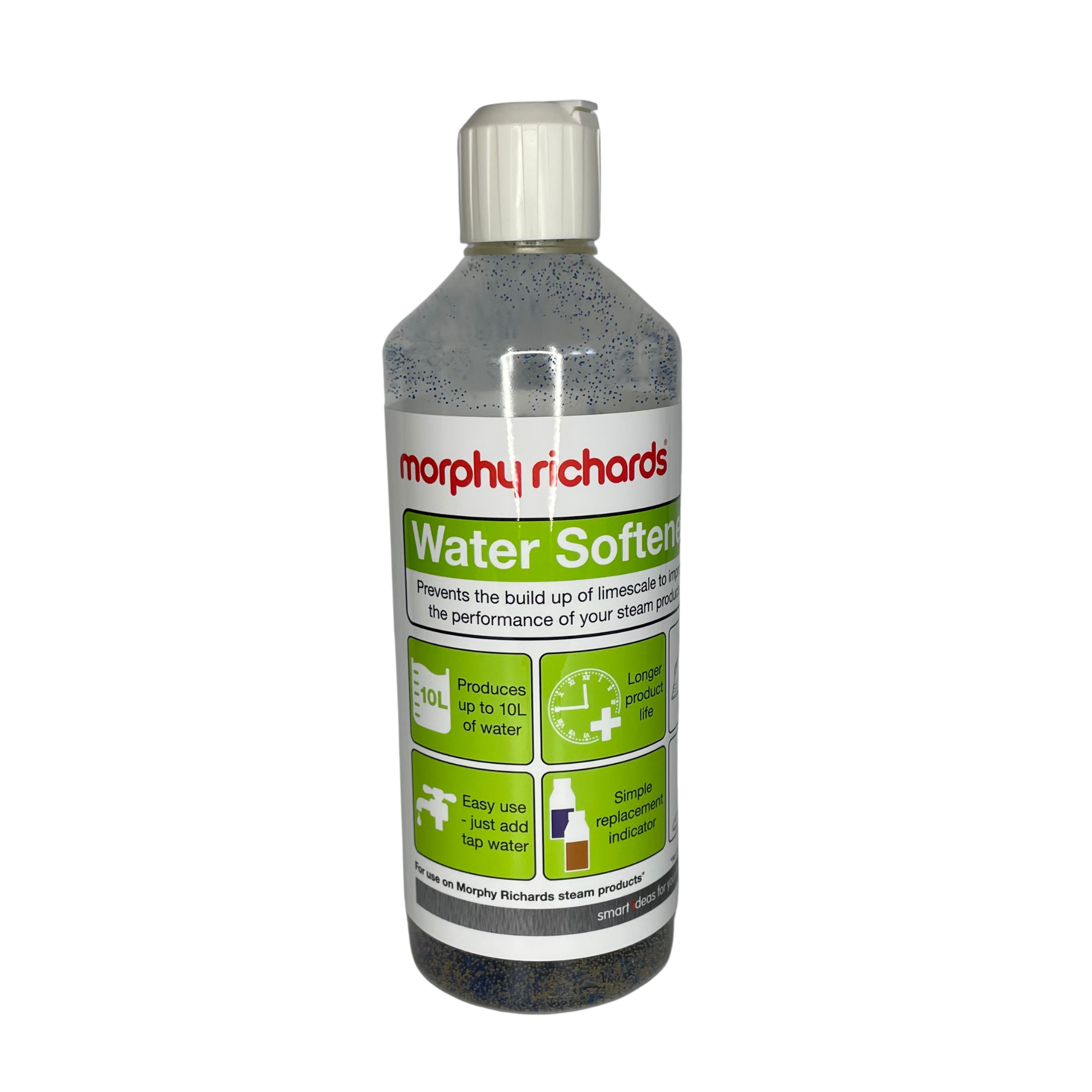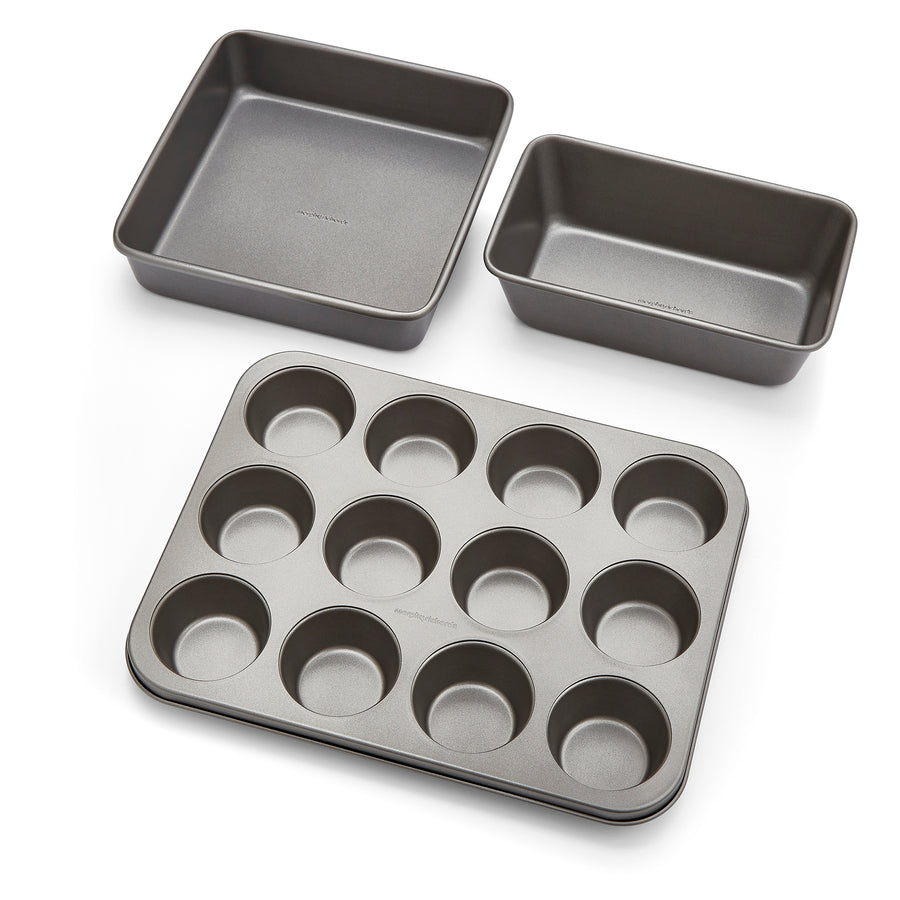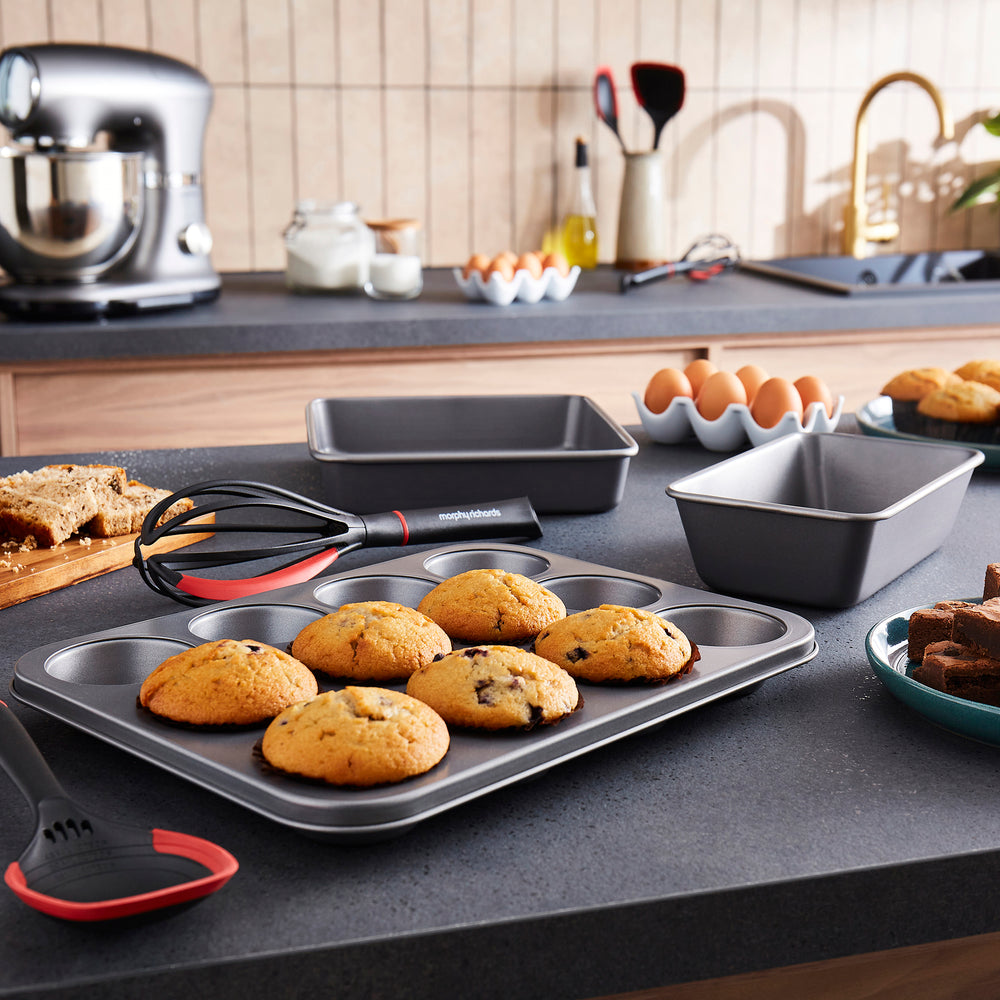Get Bake Off Ready: Bakeware Buying Guide

Bake Off is back, which means it's time to dust off the old bakery cookbooks, tittle at the abundant use of double entendres, and try not to succumb to the wintry gaze of old blue eyes Hollywood himself.
But is your kitchen fully equipped with the right bakeware to get those buns handshake-worthy, or are those old tins and trays starting to show their age? Well, worry not, because in this article, we’ll show you what you need to earn yourself the title of star baker…
What’s the difference between bakeware and cookware?
At first glance, the line between bakeware and cookware might seem thin, but there is a clear difference.
Cookware is designed to work on a hob, whereas bakeware lives in the oven.
Of course, some pieces straddle both worlds. A heavy cast-iron skillet, for example, can sear a steak on the hob before slipping into an oven to finish the job.
The choice of material differs between the two.
Cookware often uses metals that conduct heat rapidly, like aluminium, copper or thin-gauge steel, so you can adjust temperature on the fly.
Bakeware, by contrast, needs to deliver even, sustained heat, meaning that thick-gauge steel, ceramic and glass dishes are often the right choice, as they excel at retaining warmth.
Handles and lids also differ between cookware and bakeware.
Cookware is typically fitted with knobs or side-handles fashioned from Bakelite, wood or heat-resistant plastic, so that you can lift a hot pot without melting your digits.
Bakeware, on the other hand, tends to rely on wider, sturdier handles or even finger-grip recesses moulded into the tin’s rim, safe up to higher oven temperatures.
But when did these two stalwarts of the kitchen split off into separate sets? Let’s take a quick dip into the annals of history.
Long before pottery became a thing, our ancestors had to improvise cooking vessels from what they found around them. Early Stone Age roasting techniques involved covering meat or roots in clay or large leaves before placing them in embers.
To boil water in the absence of hot springs, they heated stones in the fire before dropping them into leaf-lined pits or even emptied animal stomachs filled with water, a precursor to the modern saucepan.
The arrival of permanent pottery (first seen over nineteen thousand years ago in China’s Xianrendong Cave) changed both bakeware and cookware. Glazed earthenware became waterproof and fireproof, which made them perfect for slow-cooked stews and oven-baked puddings.
Metalworking finally ushered in bronze and iron vessels. By the medieval period, kitchens used cauldrons and earthen pans with spits for roasting, and by the seventeenth century a well-stocked kitchen featured skillets, baking pans, kettles, and cauldrons in copper, brass and iron.
Advancements throughout the nineteenth and twentieth-century made steel, stainless steel and aluminium affordable, and thus the modern divide was solidified. Cookware you stir, bakeware you leave to work its magic.

Essential bakeware for every Star Baker
No kitchen would be complete without a mixed array of bakeware, but in case you don’t know your muffin trays from your flan pans, we’re here to provide a morsel of elucidation.
Oven trays
From buttery shortbread to golden roasties, a reliable oven tray is a must-have for any kitchen.
This is a very shallow tray with a thin base for oven baking, and often comes with a non-stick surface. Baking trays are typically rectangular to fit the oven shelves, but square shapes are also common.
Their versatility makes them a mainstay in the baking world, so if you’re in the market for a great set, Morphy Richards has you covered.
Our 13”x9” Oven Tray Set contains two rimmed trays made from aluminised steel. Raised edges contain drippings for roasting and baking, and the aluminised finish browns evenly without hot spots. Better yet, their stackable design makes them great for efficient storage.
Muffin & cupcake trays
Whether you’re baking jammy British buns, or rustling up some classic American muffins, the most important thing to maintaining that recognisable shape is tray rigidity.
The individual pits of a muffin tin provide the perfect size and shape to drop cake cases into, surrounding them with an even heat that allows your cakes to rise upwards rather than outwards during baking.
At Morphy Richards, the Muffin Tin, Square Cake Tin and 2 lb Loaf Tin Set gives you a 12-mould muffin tray with a square cake tin and loaf tin, all in hard-anodised aluminium. This material gives you a swift, even heating and a non-stick finish.
Yorkshire pudding tin
Who doesn’t love a good Yorkshire pud?
But while they taste great, achieving the perfect size isn’t always so straightforward. For Yorkshire puds that tower above the rim, you need a tin that’s both shallow and spacious.
Luckily, Morphy Richards has just the tin for you. The 4 Cup Yorkshire Pudding Tray Set has four 10 cm diameter wells, each just 2.5 cm deep, which makes them perfect for trapping steam and generating those coveted crispy edges.
And if you’re interested, here are our pro tips for spectacular puds:
-
Preheat the empty tray for at least ten minutes.
-
Generously oil each cup.
-
Pour in batter while the tray is still hot to kick-start the rise.
Quiche & flan pans
If you have a penchant for French cuisine, it’s hard to go wrong with a quiche. This savoury open tart consists of a flaky pastry crust, which requires a specific type of bakeware to perfect.
A fluted-edge quiche or flan pan can achieve that classic crimped rim and even base bake. Look for a removable base design, so that once your tart is set, you simply press up on the base and it releases flawlessly. Also, a heavy-gauge construction will help to prevent hotspots, and a non-stick coating will let you skip the extra grease needed for a quick release.
Pizza trays
Pizza trays are normally round, although rectangular designs are also available. The trays are thin, and have a lip or moulded handles to make for easy handling in and out of the oven.
Pizza trays are designed to give your pizza a nice and crispy base, and can be made from cast iron or hard anodised materials.
Pizza Pan and Crisper Tray Set
The Pizza Pan and Crisper Tray Set offers a 32 cm steel pan alongside a perforated crisper tray, ideal for both Neapolitan-style pizza and crisp-bottomed tartlets.
The perforations allow moisture to escape, preventing soggy crusts, and the steel construction heats rapidly for a golden underside.

Roasting tins
Roasting tins are designed to achieve perfectly browned joints and crisp-tender vegetables in one go.

Oven Tray and Roasting Tin Set
The Morphy Richards Roasting Tin Set is designed with heavy duty carbon steel and can withstand temperatures up to 230 degrees. The non-stick roasting tin has a textured base, making it easier to lift vegetables from the flat surface of the tin. Not only that, but it is dishwasher safe, so clean-up is a piece of cake.
Cake tins
Whether you’re signatureising (not a word, but let’s make it one) a Victoria sponge or tackling an intricate layer cake, perfection comes down to a solid cake tin.
Loose Base Shallow Cake Tin Set
At Morphy Richards, the Loose Base Shallow Cake Tin Set offers a 23 cm round tin that doubles as a spring-form for cheesecake enthusiasts. Made with a loose base for easy removal, and a non-stick coating for pain-free release, this set is made of heavy duty carbon steel, ensuring even heat distribution for the best baking results.
What materials are used in bakeware?
The question on everyone’s lips.
Choosing the right material can be as crucial as selecting the correct size. Each material type has its own strengths and weaknesses, making certain types of materials better suited for certain situations. Let’s look at the common materials found in bakeware.
Aluminium
Aluminium is a lightweight metal well-loved because of its rapid heat conduction and even distribution.
You’ll find it in sheet pans, loaf tins and muffin trays where swift temperature changes are essential for crisp edges and uniform rise. It's cheap, which makes it a kitchen staple, but pure aluminium can react with acidic batters (like lemon drizzle or rhubarb crumbles) causing metallic flavours and discolouration.
Top tip: pick thick-gauge, hard-anodised aluminium pans to prevent hotspots and protect delicate flavours from metallic reactions.

Cast iron
Cast iron is the big chief of bakeware, beloved worldwide for its impeccable heat retention and stability. From pie dishes to skillets, cast iron holds and radiates warmth slowly, giving breads and desserts a beautifully browned exterior.
A properly seasoned pan develops a natural non-stick finish, yet its weight means preheating takes longer and handling demands sturdy grips. Whether you’re whisking a cobbler in the oven or searing fruit on the hob before finishing under the grill, cast iron’s dual hob-to-oven capability makes it irreplaceable.
Top tip: keep your pan’s seasoning by drying immediately and occasionally rubbing with a thin layer of vegetable oil after each use.
Stainless steel
Stainless steel bakeware is well known for its great durability and resistance to rust or corrosion. You’ll spot it in roasting tins, cake tins and loaf pans, usually with an encapsulated aluminium base to offset its modest thermal conductivity.
The shiny surface of stainless steel remains pristine wash after wash, and most pieces are dishwasher safe, making stainless steel perfect for those who prize low-maintenance bakeware without sacrificing quality.
Top tip: for optimal heat transfer, select stainless steel bakeware with an aluminium or copper core.
Aluminised steel
Aluminised steel is steel coated with an aluminium alloy, allowing it to combine the strength of steel with the rapid heat conduction of aluminium.
Common in commercial-style sheet pans and loaf tins, aluminised steel heats up quickly, resists warping and browns baked goods evenly and uniformly. The aluminium layer also protects against corrosion, and its smooth finish makes cleaning straightforward, while its robustness suits high-volume bakes or heavy-duty roasting.
Top tip: hand-wash aluminised steel with warm, soapy water to protect any non-stick coating and prevent surface scratches.
Carbon steel
Pressed from thick-gauge steel, carbon steel bakeware is a lighter-weight alternative to cast iron with comparable heat retention.
You’ll find carbon steel in pizza pans, sheet trays and tart tins as its surface develops a natural patina through seasoning, creating a non-stick layer ideal for crisp pastries and golden flatbreads.
However, occasional re-seasoning is vital. Neglect it and the metal may rust or lose its release properties.
Top tip: after each wash, dry your carbon steel thoroughly and heat with a little oil to reinforce its non-stick patina.
Stoneware & porcelain
Stoneware and porcelain are fired clay products. Bakers love them for their heat-holding ability and elegant presentation.
Casserole dishes, pie plates and gratin dishes are often forged from these materials, which warm gradually and release heat slowly at the table.
Their poor conductivity means you need to preheat thoroughly and allow extra bake time, but the results are gentle, even cooking, ideal for custards, stews and slow-baked desserts.
Top tip: lower your oven temperature by 10 °C and extend bake time slightly to compensate for ceramics’ slower heat absorption.
Enamelware
Enamelware combines a steel or cast iron core with a fusion of porcelain enamel to create a hard-wearing, non-reactive surface.
Roasting tins and baking pots favour enamelware to resist chipping and staining while offering reliable heat transfer from their metal core. Their vibrant finishes also look stunning on the table.
Although most pieces are dishwasher safe, handwashing protects the enamel from cracks caused by sudden temperature changes.
Top tip: avoid dunking a hot enamel dish into cold water. Instead, allow it to cool gradually to prevent cracking.
Silicone
Silicone bakeware is one of the newer kids on the block, and is celebrated for its flexibility and inherent non-stick nature. Muffin trays, loaf pans and jelly moulds made from food-grade silicone release bakes with minimal effort and resist staining.
As an insulator, silicone heats slowly, so you’ll need to bake at slightly higher temperatures or for longer periods to achieve browned crusts. Always make sure to place silicone moulds on a rigid baking tray for stability.
Top tip: increase your bake time by around 10% and place silicone tins on a metal tray to get even support and browning.
Glass
Glass bakeware is completely non-reactive and beloved for its unique, pristine appearance, and ability to serve straight from oven to table.
Pie dishes, loaf pans and casserole dishes in borosilicate or tempered glass heat evenly but slowly, often requiring a temperature reduction of 10–15 °C to avoid over-browning. Their insulating properties keep dishes warmer for longer once removed from the oven.
Top tip: reduce your oven temperature by 10 °C and allow ingredients extra time to bake through, especially when switching from metal to glass.
That’s a lot to get through, so for your convenience, here’s a handy table of the different materials:
|
Material |
Best for |
Care |
|
Aluminium |
Even heat distribution |
Hand wash |
|
Cast iron |
Hob-to-oven cooking, heat retention |
Season and hand wash |
|
Stainless steel |
Browning and corrosion resistance |
Dishwasher safe |
|
Aluminised steel |
Uniform heating |
Hand wash |
|
Carbon steel |
High durability |
Season; hand wash |
|
Stoneware & porcelain |
Aesthetic tableware, heat retention |
Dishwasher safe if not hand-painted |
|
Enamelware |
Roasting & baking |
Dishwasher safe |
|
Silicone |
Flexible non-stick release |
Dishwasher safe |
|
Glass |
Non-reactive serving |
Dishwasher safe |
Why thickness matters
When looking at bakeware, you may have come across the “gauge”. But what does this mean?
Gauge refers to the thickness of the metal used in bakeware. A lower gauge number indicates thicker metal, which heats more slowly but retains and distributes heat evenly.
Thinner pans with a higher gauge number heat up more rapidly, which can be advantageous for quick-bake cookies, but may lead to uneven browning on larger cakes.
So when looking at gauge numbers, consider these points:
-
For cookies and biscuits: a 14-16 gauge aluminium pan will get those crisp edges without burning.
-
For cakes and tarts: aim for 12-14 gauge steel or aluminium to avoid hot spots.
Gauge may not always be specified on bakeware, so look for pans that feel solid and sit flat on a work surface.
Caring for your bakeware
Quality bakeware can last decades if maintained properly. Think Prue Leith chucks her bakeware in the cupboard after use? Of course not.
To keep your tins, trays, and dishes in show-stopping condition, follow these tips:
Seasoning
Seasoning creates a polymerised oil layer that prevents sticking and resists moisture.
Only certain materials need seasoning, most notably cast iron, carbon steel and hard-anodised aluminium, but it is important to keep on top of it if you want to get the most out of your bakeware.
Never seasoned before? Here are our tips on seasoning properly:
-
Wash with warm, soapy water and dry thoroughly.
-
Apply a thin, even coating of vegetable oil over all surfaces.
-
Bake upside down at 200°C for 45–60 minutes, placing foil underneath to catch drips.
-
Cool in the oven before wiping off excess oil.
With all that done, your bakeware will stay in tip-top shape for years to come.
Cleaning
Cleaning your bakeware is one of the most critical ways to keep them in good condition. Treat each material according to its needs.
When working with steel and cast iron, avoid soaking them to prevent the possibility of rust buildup.
Use wooden or silicone utensils to protect non-stick coatings, and steer well clear of aerosol cooking sprays, which leave a persistent residue.
Even if labelled dishwasher safe, the best way to keep them safe is with a bit of manual handwashing, which extends life and appearance. For stubborn baked-on residue, soak briefly in warm water before gentle scraping.
Storage
Lastly, don’t forget to properly store your bakeware. Avoid stacking mis-sized items on top of one another, or placing them on uneven surfaces, as this can cause damage to non-stick surfaces.
Additionally, make sure to carefully place bakeware, especially with ceramic or glassware to avoid the likelihood of cracks to breaks occurring.

Your Hollywood Handshake awaits…
Armed with the right bakeware, you’re set to impress Paul, Prue, and your fellow contestants, or simply treat your family to bakery-quality bakes at home.
And when it comes to quality bakeware, you can’t do wrong with the Morphy Richards bakeware collection.
When you buy direct from Morphy Richards, you’ll benefit from a two-year warranty (with an extra year of warranty for free when you register with us).
We also offer free shipping (on qualifying orders) and flexible payment options, so what are you waiting for?
Shop Morphy Richards bakeware sets now
For more home appliance buying guides, inspiration and recipes, explore the Morphy Richards blog…
The Best Slow Cookers: Your 5-Star Reviews | The Ultimate Guide to Buying a Soup Maker | What Is The Best Soup Maker














Leave a comment